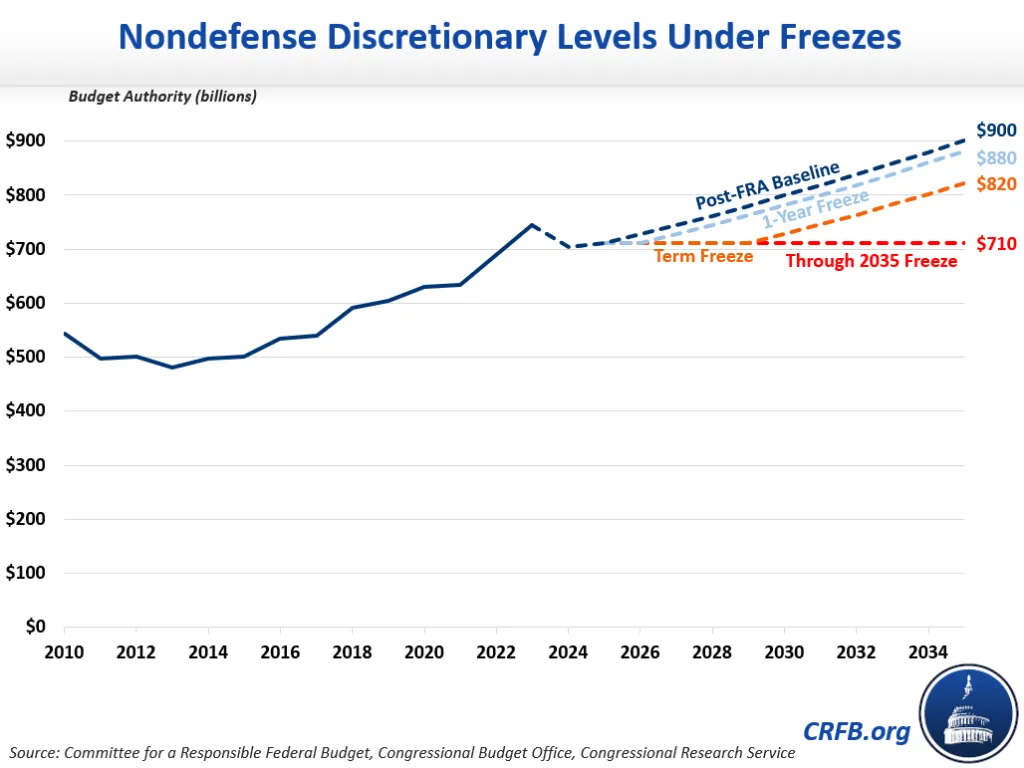Mike Pence’s Proposal to Freeze Nondefense Discretionary Spending
Republican presidential candidate Mike Pence recently proposed freezing nondefense discretionary (NDD) spending, which we estimate could save between $160 and $840 billion over the ten-year period from Fiscal Year (FY) 2026 through 2035. The following US Budget Watch 2024 explainer analyzes this policy in detail. In the coming weeks and months, we will publish additional analyses covering proposals from presidential candidates in both parties.
US Budget Watch 2024 is a project of the nonpartisan Committee for a Responsible Federal Budget designed to educate the public on the fiscal impact of presidential candidates’ proposals and platforms. Through the election, we will issue policy explainers, fact checks, budget scores, and other analyses. We do not support or oppose any candidate for public office.
Last month, former Vice President and current Republican presidential candidate Mike Pence declared that “we need to freeze nondefense domestic spending at current levels.”
Assuming Vice President Pence is referring to nondefense discretionary (NDD) spending, we estimate such a freeze would save $160 billion through FY 2035 if implemented for one year, $550 billion if implemented over a full four-year term, and $840 billion if enacted for ten years.1
We assume the freeze begins in FY 2026, after the Fiscal Responsibility Act (FRA) caps expire. This would be the first full fiscal year of the next Presidential term.
Options to Freeze Nondefense Discretionary Spending (FY 2026 – 2035)
| Proposal | Direct Savings | Total Savings |
|---|---|---|
| Freeze for One Year (FY 2026) | $15 billion | $160 billion |
| Freeze for the Presidential Term (FY 2026 – FY 2029) | $170 billion | $550 billion |
| Freeze for Ten Years (FY 2026 – FY 2035) | $840 billion | $840 billion |
Discretionary spending refers to the funds that Congress appropriates annually, which constitute roughly a quarter of overall federal spending. Approximately half of all discretionary spending goes toward national defense related programs, while the other half – nondefense discretionary spending – funds a wide variety of other initiatives ranging from education to environmental protection to homeland security.
NDD spending has risen significantly in recent years after decreases last seen a decade ago. On a nominal basis, base NDD (including funding for nondefense overseas contingency operations, or OCO) declined from $543 billion in FY 2010 to $481 billion in 2013 due largely to the imposition of spending caps and sequestration under the Budget Control Act of 2011. However, a series of Bipartisan Budget Acts lifted those sequester-level caps – some with offsets and some without – causing NDD appropriations to rise to $635 billion by 2021. The expiration of spending caps in 2022 facilitated large increases in NDD spending in both 2022 and 2023, with spending reaching $744 billion in fiscal year 2023. New caps for FY 2024 and 2025 under the Fiscal Responsibility Act of 2023 are supposed to reduce NDD levels to $704 billion in 2024 and about $710 billion in 2025 – though actual spending may be higher due to various “side deals” that may come to fruition during the appropriations process.

Adjusted for inflation, we estimate NDD spending in FY 2023 is 13 percent above the 2012 level, 20 percent above 2013, and 13 percent above 2017. Assuming the FRA is enacted in full (without side agreements), we estimate 2024 levels will be about 4 percent higher than the 2012 level, 10 percent above 2013, and 4 percent above 2017.
Our Build Your Own Discretionary Budget tool allows users to estimate the savings from further limiting discretionary spending by comparing strict enactment of the FRA to enactment with further spending limits.
Using this tool and extrapolating through FY 2035, we estimate freezing NDD for 2026 would generate $15 billion of direct savings and lead to $160 billion of savings through 2035, assuming spending otherwise continued to grow with inflation.2 Freezing NDD for four years – through a full presidential term – would generate $170 billion of direct savings and $550 billion of savings over a decade. Finally, freezing NDD spending for ten years would save $840 billion through 2035.
Importantly, putting limits on any discretionary spending would not replace the need for appropriators to identify cuts to meet these limits. A one-year freeze would require cutting NDD over 2 percent below baseline, while a long-term freeze would require cutting NDD by roughly 21 percent below baseline by FY 2035. These cuts would be on top of those enacted under the FRA and could require significant changes to spending on everything from veterans to scientific research to immigration enforcement.
One point of uncertainty in our estimates relates to what areas of the budget Vice President Pence intends to freeze. While we assume he would freeze all base NDD spending, his statement could be interpreted as exempting spending on veterans and the State Department or as incorporating certain non-base discretionary funding or even mandatory funding. Depending on what is included, savings could be larger or smaller. We also assume the freeze would begin after he took office and not literally from “current levels.” Applying the freeze relative to FY 2023 would save less, since the FRA requires nominal cuts in 2024. Finally, we assume the freeze is relative to the full enactment of the FRA. If the various side deals are put into effect and spending is frozen from there, a ten-year freeze would save about $890 billion relative to a baseline with those side deals.
*****
Throughout the 2024 presidential election cycle, US Budget Watch 2024 will bring information and accountability to the campaign by analyzing candidates’ proposals, fact-checking their claims, and scoring the fiscal cost of their agendas.
By injecting an impartial, fact-based approach into the national conversation, US Budget Watch 2024 will help voters better understand the nuances of the candidates’ policy proposals and what they would mean for the country’s economic and fiscal future.
You can find more US Budget Watch 2024 content here.
1 We assume Vice President Pence is proposing to freeze “base” nondefense discretionary spending. Base spending excludes adjustments for program integrity, wildfire suppression, and regular adjustments for disaster relief. It also excludes funding related to the Infrastructure Investment and Jobs Act (IIJA), funding for Ukraine, and other one-time emergency and supplemental disaster appropriations.
2 When making projections for discretionary spending, the Congressional Budget Office assumes that spending grows with inflation each year unless constrained by caps or some other statutory limitation. Therefore, any reduction in discretionary spending below the current law baseline will not only result in savings in the years that spending is reduced, but also over the entire budget window. For our estimates, we likewise assume that nondefense discretionary spending grows with inflation once the freeze is over, resulting in direct savings in the years affected by the different freeze scenarios as well as indirect savings throughout the budget window.


